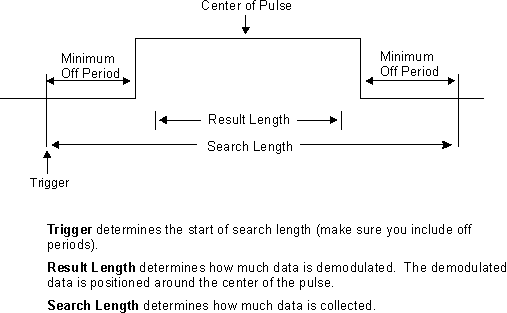Pulse Search Enable (Custom IQ)
demodulates pulsed (burst) transmissions. Selecting the check box turns on ; clearing it disables .
Digital communication systems that use pulsed transmissions send and receive information in bursts (such as those in mobile units). In other words, carrier power is switched on and off. The carrier switches on when the transmitter transmits data and switches off when the transmitter finishes transmitting data. If is on, the demodulator searches within the defined to locate the first complete pulse, which can occur anywhere in the . Pulses beyond the first complete pulse are disregarded and are not demodulated. In order for the algorithm to detect a pulse edge, the pulse must be at least 15 dB above the noise floor. The resultant pulse is then demodulated. If Pattern Search is selected in addition to , the demodulator performs first then performs sync search on the resultant demodulated pulse as illustrated below.

The , which includes both the offset and the sync word, must not violate the boundaries of the demodulated pulse.
Using Pulse Search
There are two ways to use :
- with OFF
- with ON
Pulse Search with Pattern Search OFF
When is used and is disabled, these parameters determine how the demodulator searches for the pulse and the data that is demodulated:
determines the length of time over which the demodulator searches for a complete pulse (off-on-off).
The trigger signal determines when the demodulator begins its search.
determines how much information is demodulated. Only the first pulse detected in the search region is demodulated.
The demodulator automatically centers the with respect to the pulse. In other words, the demodulator positions the around the center of the pulse, as shown below.

Pulse Search With Pattern Search ON
When is used and is enabled, these parameters determine how the demodulator searches for the pulse and the data that is demodulated:
When is ON, the demodulator searches for a pulse within the . The demodulator demodulates the entire pulse to locate the synchronization pattern (also called sync pattern or sync word). If there are multiple pulses within the , the demodulator demodulates only the first pulse.
The demodulator uses the and the to position the ¾the is NOT centered around the center of the pulse.
